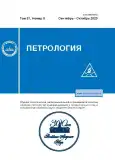Microprobe Analysis of Titanium in Zircon: an Estimation of Secondary Fluorescence
- Authors: Borisov A.A.1, Borisovskiy S.E.1, Koshlyakova A.N.1,2
-
Affiliations:
- Institute of Geology of Ore Deposits, Petrography, Mineralogy, and Geochemistry, Russian Academy of Sciences
- Vernadsky Institute of Geochemistry and Analytical Chemistry, Russian Academy of Sciences
- Issue: Vol 31, No 5 (2023)
- Pages: 570-574
- Section: Articles
- URL: https://journals.rcsi.science/0869-5903/article/view/141019
- DOI: https://doi.org/10.31857/S0869590323050035
- EDN: https://elibrary.ru/TMENFP
- ID: 141019
Cite item
Full Text
Abstract
Microprobe study of the effects of secondary fluorescence from high-titania glass (TiO2 ≈ 16 wt %) on apparent titanium content in Ti-free zircon was conducted. It was demonstrated that small crystals (<10 µm) are not suitable for analysis. In boundary parts of large zircon crystals (20–30 µm) the error in Ti estimation may reach 10–23%. However, in central parts of large crystals (> 30 µm) the microprobe analysis gives practically undistorted titanium contents.
Keywords
About the authors
A. A. Borisov
Institute of Geology of Ore Deposits, Petrography, Mineralogy, and Geochemistry,Russian Academy of Sciences
Author for correspondence.
Email: aborisov@igem.ru
Russia, Moscow
S. E. Borisovskiy
Institute of Geology of Ore Deposits, Petrography, Mineralogy, and Geochemistry,Russian Academy of Sciences
Email: aborisov@igem.ru
Russia, Moscow
A. N. Koshlyakova
Institute of Geology of Ore Deposits, Petrography, Mineralogy, and Geochemistry,Russian Academy of Sciences; Vernadsky Institute of Geochemistry and Analytical Chemistry, Russian Academy of Sciences
Email: aborisov@igem.ru
Russia, Moscow; Russia, Moscow
References
- Пономаренко А.И. Включения силикатов, окислов и сульфидов в цирконе из кимберлитовой трубки “Мир” (Якутия) // Докл. АН СССР. 1979. Т. 249. № 6. С. 1442–1446.
- Batanova V.G., Sobolev A.V., Kuzmin D.V. Trace element analysis of olivine: High precision analytical method for JEOL JXA-8230 electron probe microanalyser // Chemical Geol. 2015. V. 419. P. 149–157.
- Bloch E.M., Jollands M.C., Tollan P. et al. Diffusion anisotropy of Ti in zircon and implications for Ti-in-zircon thermometry // Earth Planet. Sci. Lett. 2022. V. 578. Paper 117317.
- Borisov A., Aranovich L. Zircon solubility in silicate melts: New experiments and probability of zircon crystallization in deeply evolved basic melts // Chemical Geol. 2019. V. 510. P. 103–112.
- Borisov A., Aranovich L. Rutile solubility and TiO2 activity in silicate melts: An experimental study // Chemical Geol. 2020. V. 556. Paper 119817.
- Borisov A., Pack A., Kropf A., Palme H. Partitioning of Na between olivine and melt: An experimental study with application to the formation of meteoritic Na2O-rich chondrule glass and refractory forsterite grains // Geochim. Cosmochim. Acta. 2008. V. 72. P. 5558–5573.
- Ferry J.M., Watson E.B. New thermodynamic models and revised calibrations for the Ti-in-zircon and Zr-in-rutile thermometers // Contrib. Mineral. Petrol. 2007. V. 154. P. 429–437.
- Gavrilenko M., Batanova V.G., Llovet X. et al. Secondary fluorescence effect quantification of EPMA analyses of olivine grains embedded in basaltic glass // Chemical Geol. 2023. V. 621. Article 121328.
- Hofmann A.E., Baker M.B., Eile J.M. An experimental study of Ti and Zr partitioning among zircon, rutile, and granitic melt // Contrib. Mineral. Petrol. 2013. V. 166. P. 235–253.
- Watson E.B. Calcium content of forsterite coexisting with silicate liquid in the system Na2O–CaO–MgO–Al2O3–SiO2 // Amer. Mineral. 1979. V. 64. P. 824–829.
- Watson E.B., Wark D.A., Thomas J.B. Crystallization thermometers for zircon and rutile // Contrib. Mineral. Petrol. 2006. V. 151. P. 413–433.
Supplementary files













